Role of Responders: Legislation and Preparedness in Emergencies
VerifiedAdded on 2024/05/14
|18
|4705
|364
Report
AI Summary
This report examines the role of public service organizations in the UK during disasters and emergencies, focusing on relevant legislation such as the Civil Contingencies Act 2004 and the roles of Category 1 and 2 responders. It discusses the importance of military support through Military Aid to the Civil Authority (MACA) and Training and Logistic Assistance to the Civil Power (TLACP). The report also explores the emergency planning process, including mitigation, preparedness, response, and recovery, highlighting the roles played by various public services such as local police, fire services, and ambulance facilities. Key considerations for public services in emergency planning, such as Business Continuity Management (BCM) and collaboration with agencies like the NHS and environmental agencies, are also assessed. The report references specific incidents like the Somerset Floods and terror attacks to illustrate the practical application of emergency response strategies.
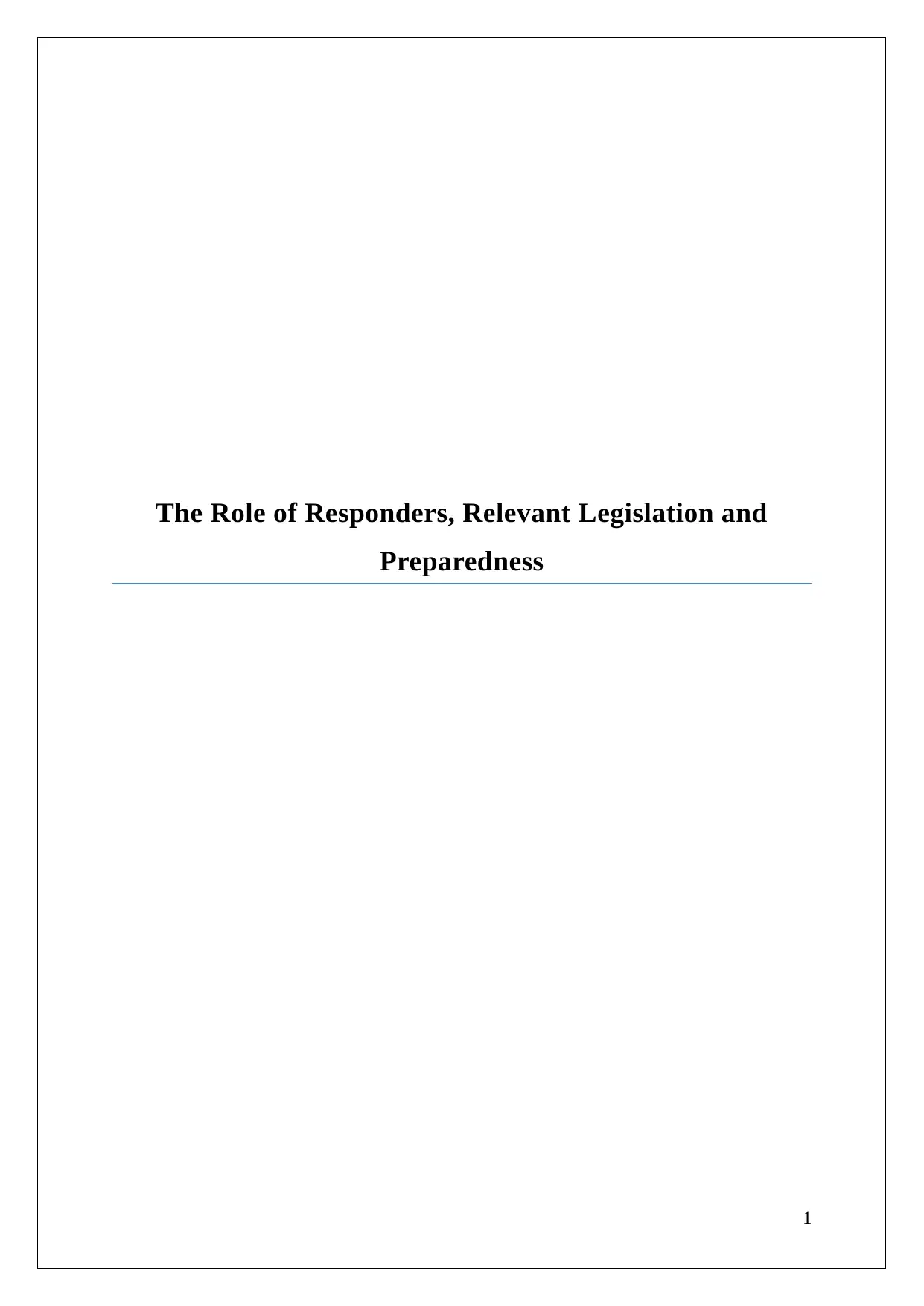
The Role of Responders, Relevant Legislation and
Preparedness
1
Preparedness
1
Paraphrase This Document
Need a fresh take? Get an instant paraphrase of this document with our AI Paraphraser
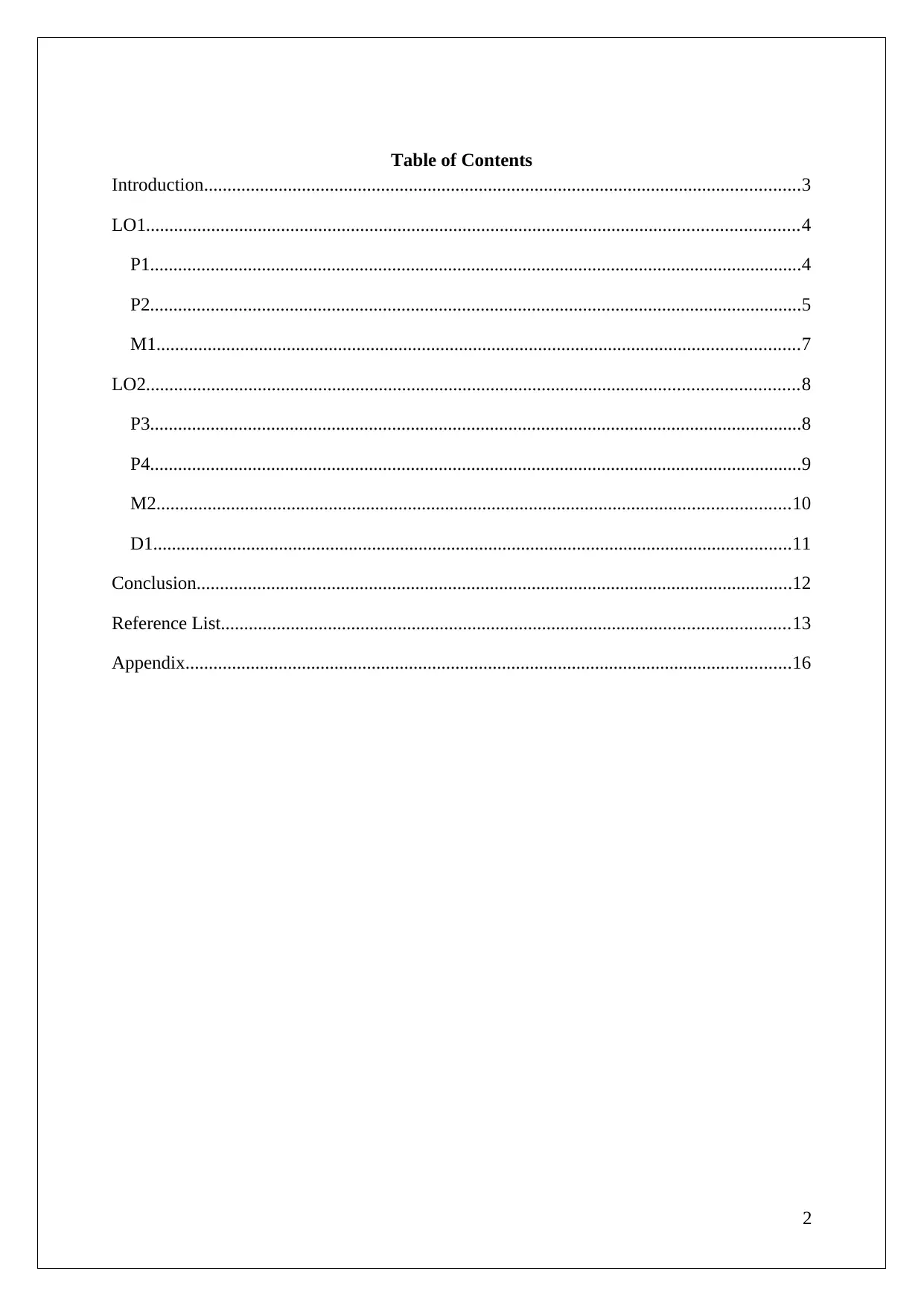
Table of Contents
Introduction................................................................................................................................3
LO1............................................................................................................................................4
P1............................................................................................................................................4
P2............................................................................................................................................5
M1..........................................................................................................................................7
LO2............................................................................................................................................8
P3............................................................................................................................................8
P4............................................................................................................................................9
M2........................................................................................................................................10
D1.........................................................................................................................................11
Conclusion................................................................................................................................12
Reference List..........................................................................................................................13
Appendix..................................................................................................................................16
2
Introduction................................................................................................................................3
LO1............................................................................................................................................4
P1............................................................................................................................................4
P2............................................................................................................................................5
M1..........................................................................................................................................7
LO2............................................................................................................................................8
P3............................................................................................................................................8
P4............................................................................................................................................9
M2........................................................................................................................................10
D1.........................................................................................................................................11
Conclusion................................................................................................................................12
Reference List..........................................................................................................................13
Appendix..................................................................................................................................16
2
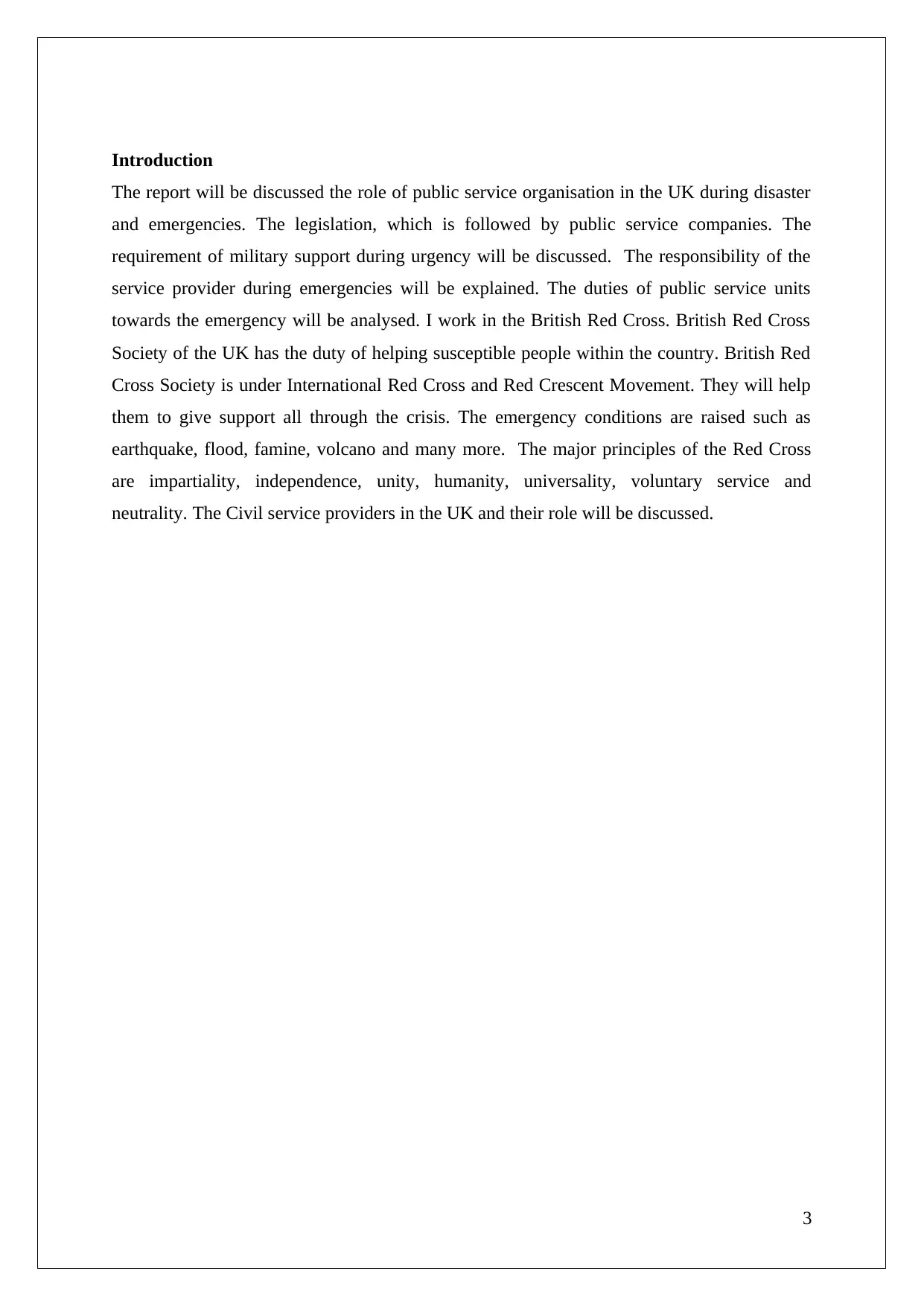
Introduction
The report will be discussed the role of public service organisation in the UK during disaster
and emergencies. The legislation, which is followed by public service companies. The
requirement of military support during urgency will be discussed. The responsibility of the
service provider during emergencies will be explained. The duties of public service units
towards the emergency will be analysed. I work in the British Red Cross. British Red Cross
Society of the UK has the duty of helping susceptible people within the country. British Red
Cross Society is under International Red Cross and Red Crescent Movement. They will help
them to give support all through the crisis. The emergency conditions are raised such as
earthquake, flood, famine, volcano and many more. The major principles of the Red Cross
are impartiality, independence, unity, humanity, universality, voluntary service and
neutrality. The Civil service providers in the UK and their role will be discussed.
3
The report will be discussed the role of public service organisation in the UK during disaster
and emergencies. The legislation, which is followed by public service companies. The
requirement of military support during urgency will be discussed. The responsibility of the
service provider during emergencies will be explained. The duties of public service units
towards the emergency will be analysed. I work in the British Red Cross. British Red Cross
Society of the UK has the duty of helping susceptible people within the country. British Red
Cross Society is under International Red Cross and Red Crescent Movement. They will help
them to give support all through the crisis. The emergency conditions are raised such as
earthquake, flood, famine, volcano and many more. The major principles of the Red Cross
are impartiality, independence, unity, humanity, universality, voluntary service and
neutrality. The Civil service providers in the UK and their role will be discussed.
3
⊘ This is a preview!⊘
Do you want full access?
Subscribe today to unlock all pages.

Trusted by 1+ million students worldwide
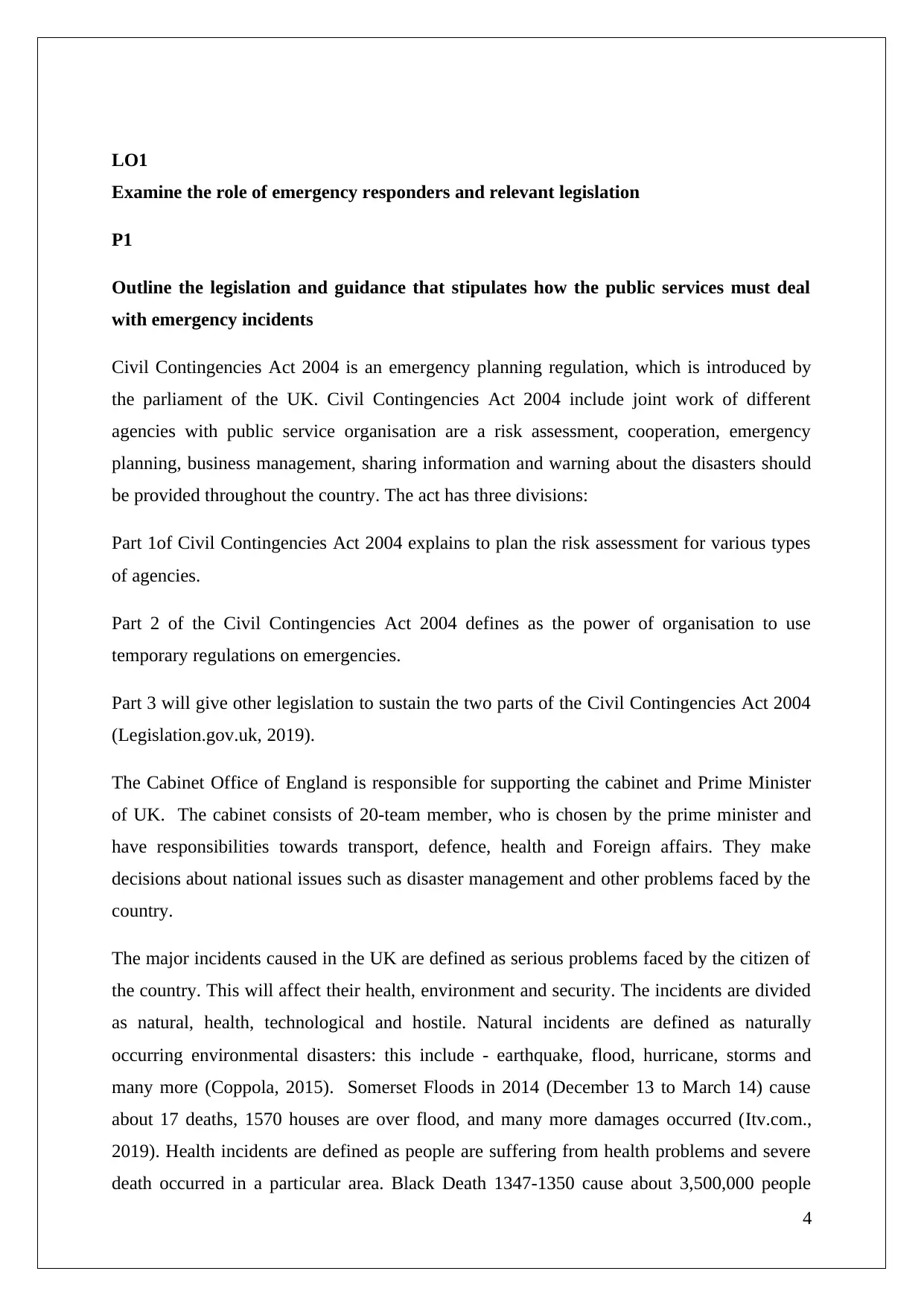
LO1
Examine the role of emergency responders and relevant legislation
P1
Outline the legislation and guidance that stipulates how the public services must deal
with emergency incidents
Civil Contingencies Act 2004 is an emergency planning regulation, which is introduced by
the parliament of the UK. Civil Contingencies Act 2004 include joint work of different
agencies with public service organisation are a risk assessment, cooperation, emergency
planning, business management, sharing information and warning about the disasters should
be provided throughout the country. The act has three divisions:
Part 1of Civil Contingencies Act 2004 explains to plan the risk assessment for various types
of agencies.
Part 2 of the Civil Contingencies Act 2004 defines as the power of organisation to use
temporary regulations on emergencies.
Part 3 will give other legislation to sustain the two parts of the Civil Contingencies Act 2004
(Legislation.gov.uk, 2019).
The Cabinet Office of England is responsible for supporting the cabinet and Prime Minister
of UK. The cabinet consists of 20-team member, who is chosen by the prime minister and
have responsibilities towards transport, defence, health and Foreign affairs. They make
decisions about national issues such as disaster management and other problems faced by the
country.
The major incidents caused in the UK are defined as serious problems faced by the citizen of
the country. This will affect their health, environment and security. The incidents are divided
as natural, health, technological and hostile. Natural incidents are defined as naturally
occurring environmental disasters: this include - earthquake, flood, hurricane, storms and
many more (Coppola, 2015). Somerset Floods in 2014 (December 13 to March 14) cause
about 17 deaths, 1570 houses are over flood, and many more damages occurred (Itv.com.,
2019). Health incidents are defined as people are suffering from health problems and severe
death occurred in a particular area. Black Death 1347-1350 cause about 3,500,000 people
4
Examine the role of emergency responders and relevant legislation
P1
Outline the legislation and guidance that stipulates how the public services must deal
with emergency incidents
Civil Contingencies Act 2004 is an emergency planning regulation, which is introduced by
the parliament of the UK. Civil Contingencies Act 2004 include joint work of different
agencies with public service organisation are a risk assessment, cooperation, emergency
planning, business management, sharing information and warning about the disasters should
be provided throughout the country. The act has three divisions:
Part 1of Civil Contingencies Act 2004 explains to plan the risk assessment for various types
of agencies.
Part 2 of the Civil Contingencies Act 2004 defines as the power of organisation to use
temporary regulations on emergencies.
Part 3 will give other legislation to sustain the two parts of the Civil Contingencies Act 2004
(Legislation.gov.uk, 2019).
The Cabinet Office of England is responsible for supporting the cabinet and Prime Minister
of UK. The cabinet consists of 20-team member, who is chosen by the prime minister and
have responsibilities towards transport, defence, health and Foreign affairs. They make
decisions about national issues such as disaster management and other problems faced by the
country.
The major incidents caused in the UK are defined as serious problems faced by the citizen of
the country. This will affect their health, environment and security. The incidents are divided
as natural, health, technological and hostile. Natural incidents are defined as naturally
occurring environmental disasters: this include - earthquake, flood, hurricane, storms and
many more (Coppola, 2015). Somerset Floods in 2014 (December 13 to March 14) cause
about 17 deaths, 1570 houses are over flood, and many more damages occurred (Itv.com.,
2019). Health incidents are defined as people are suffering from health problems and severe
death occurred in a particular area. Black Death 1347-1350 cause about 3,500,000 people
4
Paraphrase This Document
Need a fresh take? Get an instant paraphrase of this document with our AI Paraphraser
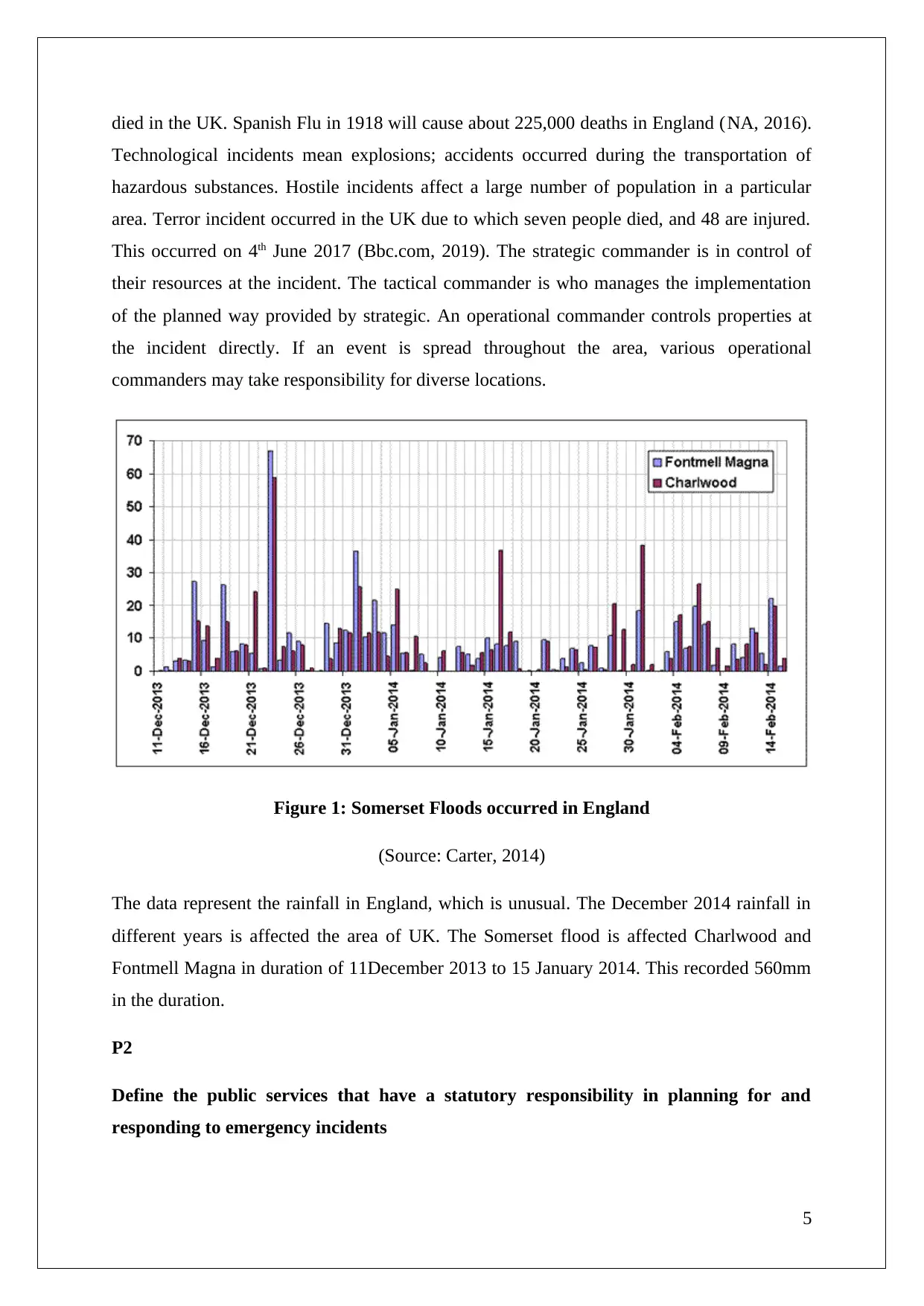
died in the UK. Spanish Flu in 1918 will cause about 225,000 deaths in England (NA, 2016).
Technological incidents mean explosions; accidents occurred during the transportation of
hazardous substances. Hostile incidents affect a large number of population in a particular
area. Terror incident occurred in the UK due to which seven people died, and 48 are injured.
This occurred on 4th June 2017 (Bbc.com, 2019). The strategic commander is in control of
their resources at the incident. The tactical commander is who manages the implementation
of the planned way provided by strategic. An operational commander controls properties at
the incident directly. If an event is spread throughout the area, various operational
commanders may take responsibility for diverse locations.
Figure 1: Somerset Floods occurred in England
(Source: Carter, 2014)
The data represent the rainfall in England, which is unusual. The December 2014 rainfall in
different years is affected the area of UK. The Somerset flood is affected Charlwood and
Fontmell Magna in duration of 11December 2013 to 15 January 2014. This recorded 560mm
in the duration.
P2
Define the public services that have a statutory responsibility in planning for and
responding to emergency incidents
5
Technological incidents mean explosions; accidents occurred during the transportation of
hazardous substances. Hostile incidents affect a large number of population in a particular
area. Terror incident occurred in the UK due to which seven people died, and 48 are injured.
This occurred on 4th June 2017 (Bbc.com, 2019). The strategic commander is in control of
their resources at the incident. The tactical commander is who manages the implementation
of the planned way provided by strategic. An operational commander controls properties at
the incident directly. If an event is spread throughout the area, various operational
commanders may take responsibility for diverse locations.
Figure 1: Somerset Floods occurred in England
(Source: Carter, 2014)
The data represent the rainfall in England, which is unusual. The December 2014 rainfall in
different years is affected the area of UK. The Somerset flood is affected Charlwood and
Fontmell Magna in duration of 11December 2013 to 15 January 2014. This recorded 560mm
in the duration.
P2
Define the public services that have a statutory responsibility in planning for and
responding to emergency incidents
5
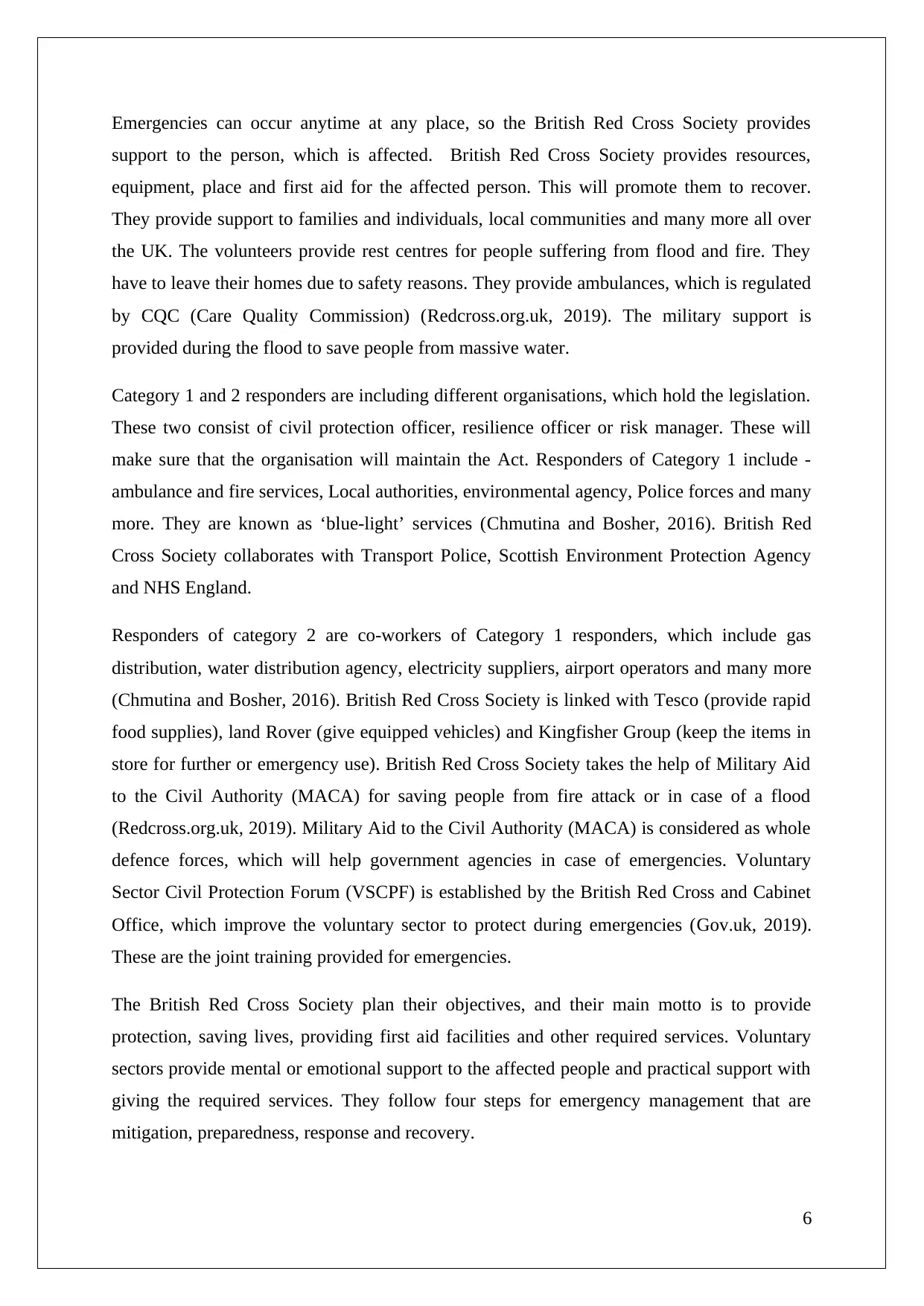
Emergencies can occur anytime at any place, so the British Red Cross Society provides
support to the person, which is affected. British Red Cross Society provides resources,
equipment, place and first aid for the affected person. This will promote them to recover.
They provide support to families and individuals, local communities and many more all over
the UK. The volunteers provide rest centres for people suffering from flood and fire. They
have to leave their homes due to safety reasons. They provide ambulances, which is regulated
by CQC (Care Quality Commission) (Redcross.org.uk, 2019). The military support is
provided during the flood to save people from massive water.
Category 1 and 2 responders are including different organisations, which hold the legislation.
These two consist of civil protection officer, resilience officer or risk manager. These will
make sure that the organisation will maintain the Act. Responders of Category 1 include -
ambulance and fire services, Local authorities, environmental agency, Police forces and many
more. They are known as ‘blue-light’ services (Chmutina and Bosher, 2016). British Red
Cross Society collaborates with Transport Police, Scottish Environment Protection Agency
and NHS England.
Responders of category 2 are co-workers of Category 1 responders, which include gas
distribution, water distribution agency, electricity suppliers, airport operators and many more
(Chmutina and Bosher, 2016). British Red Cross Society is linked with Tesco (provide rapid
food supplies), land Rover (give equipped vehicles) and Kingfisher Group (keep the items in
store for further or emergency use). British Red Cross Society takes the help of Military Aid
to the Civil Authority (MACA) for saving people from fire attack or in case of a flood
(Redcross.org.uk, 2019). Military Aid to the Civil Authority (MACA) is considered as whole
defence forces, which will help government agencies in case of emergencies. Voluntary
Sector Civil Protection Forum (VSCPF) is established by the British Red Cross and Cabinet
Office, which improve the voluntary sector to protect during emergencies (Gov.uk, 2019).
These are the joint training provided for emergencies.
The British Red Cross Society plan their objectives, and their main motto is to provide
protection, saving lives, providing first aid facilities and other required services. Voluntary
sectors provide mental or emotional support to the affected people and practical support with
giving the required services. They follow four steps for emergency management that are
mitigation, preparedness, response and recovery.
6
support to the person, which is affected. British Red Cross Society provides resources,
equipment, place and first aid for the affected person. This will promote them to recover.
They provide support to families and individuals, local communities and many more all over
the UK. The volunteers provide rest centres for people suffering from flood and fire. They
have to leave their homes due to safety reasons. They provide ambulances, which is regulated
by CQC (Care Quality Commission) (Redcross.org.uk, 2019). The military support is
provided during the flood to save people from massive water.
Category 1 and 2 responders are including different organisations, which hold the legislation.
These two consist of civil protection officer, resilience officer or risk manager. These will
make sure that the organisation will maintain the Act. Responders of Category 1 include -
ambulance and fire services, Local authorities, environmental agency, Police forces and many
more. They are known as ‘blue-light’ services (Chmutina and Bosher, 2016). British Red
Cross Society collaborates with Transport Police, Scottish Environment Protection Agency
and NHS England.
Responders of category 2 are co-workers of Category 1 responders, which include gas
distribution, water distribution agency, electricity suppliers, airport operators and many more
(Chmutina and Bosher, 2016). British Red Cross Society is linked with Tesco (provide rapid
food supplies), land Rover (give equipped vehicles) and Kingfisher Group (keep the items in
store for further or emergency use). British Red Cross Society takes the help of Military Aid
to the Civil Authority (MACA) for saving people from fire attack or in case of a flood
(Redcross.org.uk, 2019). Military Aid to the Civil Authority (MACA) is considered as whole
defence forces, which will help government agencies in case of emergencies. Voluntary
Sector Civil Protection Forum (VSCPF) is established by the British Red Cross and Cabinet
Office, which improve the voluntary sector to protect during emergencies (Gov.uk, 2019).
These are the joint training provided for emergencies.
The British Red Cross Society plan their objectives, and their main motto is to provide
protection, saving lives, providing first aid facilities and other required services. Voluntary
sectors provide mental or emotional support to the affected people and practical support with
giving the required services. They follow four steps for emergency management that are
mitigation, preparedness, response and recovery.
6
⊘ This is a preview!⊘
Do you want full access?
Subscribe today to unlock all pages.

Trusted by 1+ million students worldwide
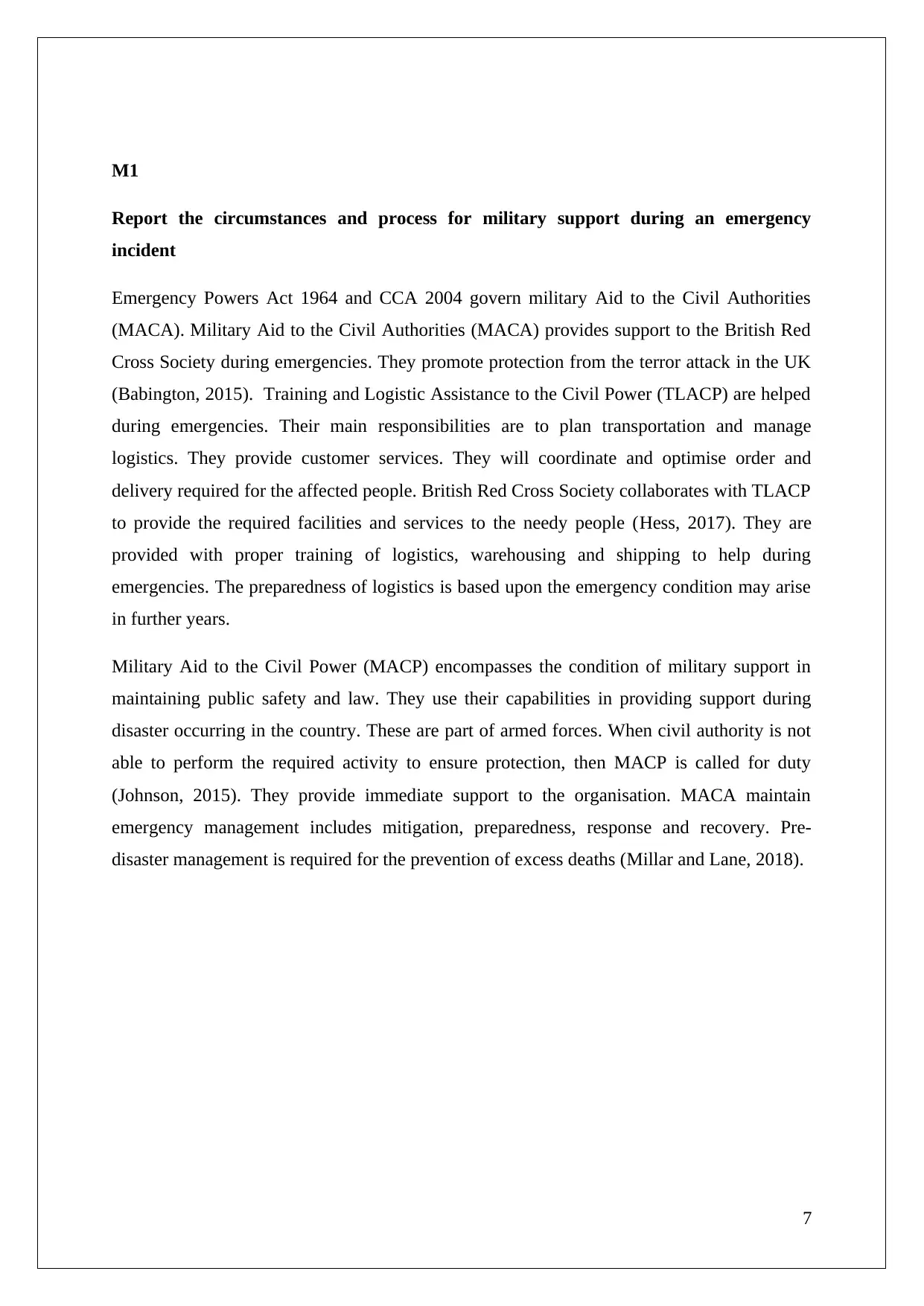
M1
Report the circumstances and process for military support during an emergency
incident
Emergency Powers Act 1964 and CCA 2004 govern military Aid to the Civil Authorities
(MACA). Military Aid to the Civil Authorities (MACA) provides support to the British Red
Cross Society during emergencies. They promote protection from the terror attack in the UK
(Babington, 2015). Training and Logistic Assistance to the Civil Power (TLACP) are helped
during emergencies. Their main responsibilities are to plan transportation and manage
logistics. They provide customer services. They will coordinate and optimise order and
delivery required for the affected people. British Red Cross Society collaborates with TLACP
to provide the required facilities and services to the needy people (Hess, 2017). They are
provided with proper training of logistics, warehousing and shipping to help during
emergencies. The preparedness of logistics is based upon the emergency condition may arise
in further years.
Military Aid to the Civil Power (MACP) encompasses the condition of military support in
maintaining public safety and law. They use their capabilities in providing support during
disaster occurring in the country. These are part of armed forces. When civil authority is not
able to perform the required activity to ensure protection, then MACP is called for duty
(Johnson, 2015). They provide immediate support to the organisation. MACA maintain
emergency management includes mitigation, preparedness, response and recovery. Pre-
disaster management is required for the prevention of excess deaths (Millar and Lane, 2018).
7
Report the circumstances and process for military support during an emergency
incident
Emergency Powers Act 1964 and CCA 2004 govern military Aid to the Civil Authorities
(MACA). Military Aid to the Civil Authorities (MACA) provides support to the British Red
Cross Society during emergencies. They promote protection from the terror attack in the UK
(Babington, 2015). Training and Logistic Assistance to the Civil Power (TLACP) are helped
during emergencies. Their main responsibilities are to plan transportation and manage
logistics. They provide customer services. They will coordinate and optimise order and
delivery required for the affected people. British Red Cross Society collaborates with TLACP
to provide the required facilities and services to the needy people (Hess, 2017). They are
provided with proper training of logistics, warehousing and shipping to help during
emergencies. The preparedness of logistics is based upon the emergency condition may arise
in further years.
Military Aid to the Civil Power (MACP) encompasses the condition of military support in
maintaining public safety and law. They use their capabilities in providing support during
disaster occurring in the country. These are part of armed forces. When civil authority is not
able to perform the required activity to ensure protection, then MACP is called for duty
(Johnson, 2015). They provide immediate support to the organisation. MACA maintain
emergency management includes mitigation, preparedness, response and recovery. Pre-
disaster management is required for the prevention of excess deaths (Millar and Lane, 2018).
7
Paraphrase This Document
Need a fresh take? Get an instant paraphrase of this document with our AI Paraphraser
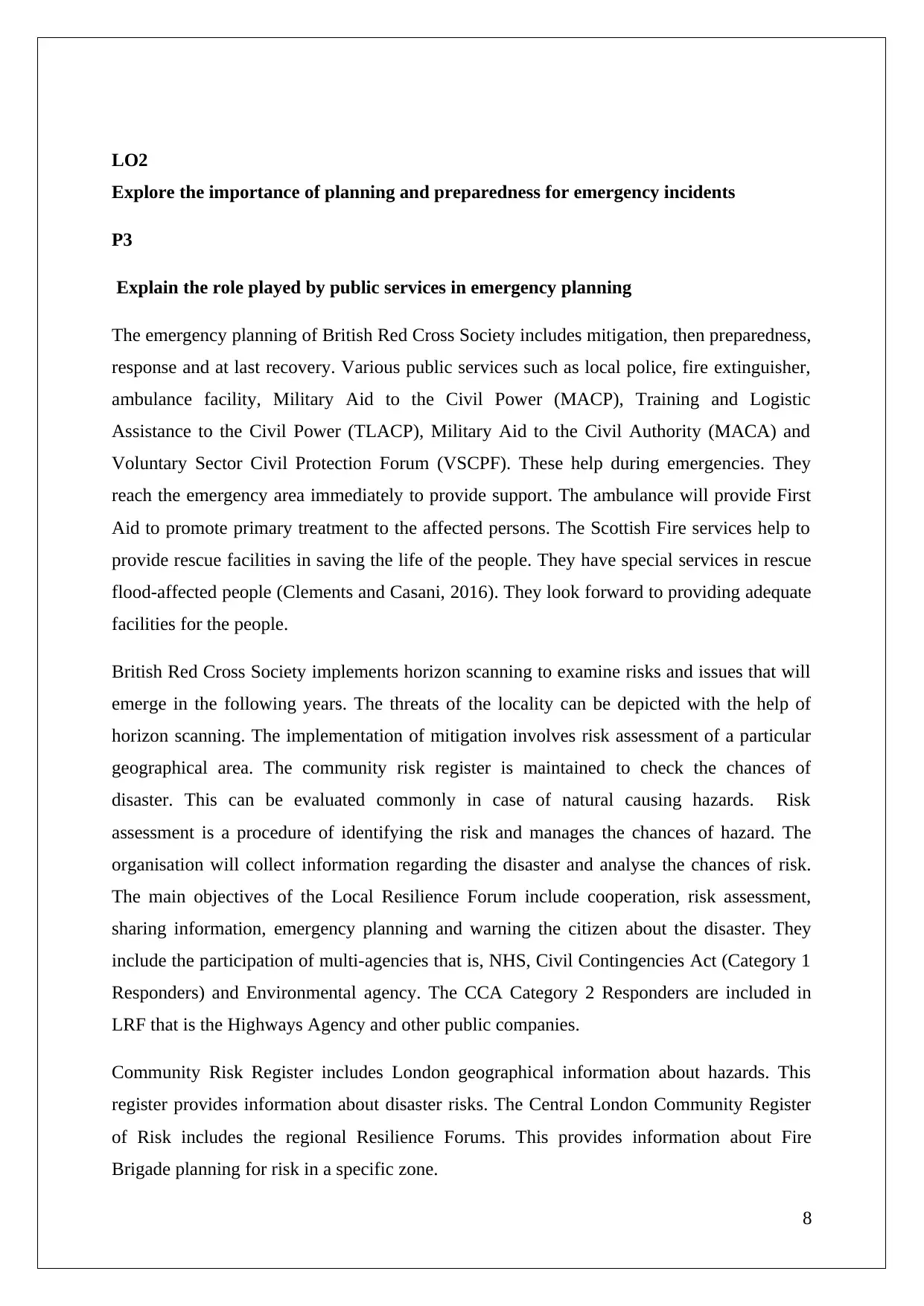
LO2
Explore the importance of planning and preparedness for emergency incidents
P3
Explain the role played by public services in emergency planning
The emergency planning of British Red Cross Society includes mitigation, then preparedness,
response and at last recovery. Various public services such as local police, fire extinguisher,
ambulance facility, Military Aid to the Civil Power (MACP), Training and Logistic
Assistance to the Civil Power (TLACP), Military Aid to the Civil Authority (MACA) and
Voluntary Sector Civil Protection Forum (VSCPF). These help during emergencies. They
reach the emergency area immediately to provide support. The ambulance will provide First
Aid to promote primary treatment to the affected persons. The Scottish Fire services help to
provide rescue facilities in saving the life of the people. They have special services in rescue
flood-affected people (Clements and Casani, 2016). They look forward to providing adequate
facilities for the people.
British Red Cross Society implements horizon scanning to examine risks and issues that will
emerge in the following years. The threats of the locality can be depicted with the help of
horizon scanning. The implementation of mitigation involves risk assessment of a particular
geographical area. The community risk register is maintained to check the chances of
disaster. This can be evaluated commonly in case of natural causing hazards. Risk
assessment is a procedure of identifying the risk and manages the chances of hazard. The
organisation will collect information regarding the disaster and analyse the chances of risk.
The main objectives of the Local Resilience Forum include cooperation, risk assessment,
sharing information, emergency planning and warning the citizen about the disaster. They
include the participation of multi-agencies that is, NHS, Civil Contingencies Act (Category 1
Responders) and Environmental agency. The CCA Category 2 Responders are included in
LRF that is the Highways Agency and other public companies.
Community Risk Register includes London geographical information about hazards. This
register provides information about disaster risks. The Central London Community Register
of Risk includes the regional Resilience Forums. This provides information about Fire
Brigade planning for risk in a specific zone.
8
Explore the importance of planning and preparedness for emergency incidents
P3
Explain the role played by public services in emergency planning
The emergency planning of British Red Cross Society includes mitigation, then preparedness,
response and at last recovery. Various public services such as local police, fire extinguisher,
ambulance facility, Military Aid to the Civil Power (MACP), Training and Logistic
Assistance to the Civil Power (TLACP), Military Aid to the Civil Authority (MACA) and
Voluntary Sector Civil Protection Forum (VSCPF). These help during emergencies. They
reach the emergency area immediately to provide support. The ambulance will provide First
Aid to promote primary treatment to the affected persons. The Scottish Fire services help to
provide rescue facilities in saving the life of the people. They have special services in rescue
flood-affected people (Clements and Casani, 2016). They look forward to providing adequate
facilities for the people.
British Red Cross Society implements horizon scanning to examine risks and issues that will
emerge in the following years. The threats of the locality can be depicted with the help of
horizon scanning. The implementation of mitigation involves risk assessment of a particular
geographical area. The community risk register is maintained to check the chances of
disaster. This can be evaluated commonly in case of natural causing hazards. Risk
assessment is a procedure of identifying the risk and manages the chances of hazard. The
organisation will collect information regarding the disaster and analyse the chances of risk.
The main objectives of the Local Resilience Forum include cooperation, risk assessment,
sharing information, emergency planning and warning the citizen about the disaster. They
include the participation of multi-agencies that is, NHS, Civil Contingencies Act (Category 1
Responders) and Environmental agency. The CCA Category 2 Responders are included in
LRF that is the Highways Agency and other public companies.
Community Risk Register includes London geographical information about hazards. This
register provides information about disaster risks. The Central London Community Register
of Risk includes the regional Resilience Forums. This provides information about Fire
Brigade planning for risk in a specific zone.
8
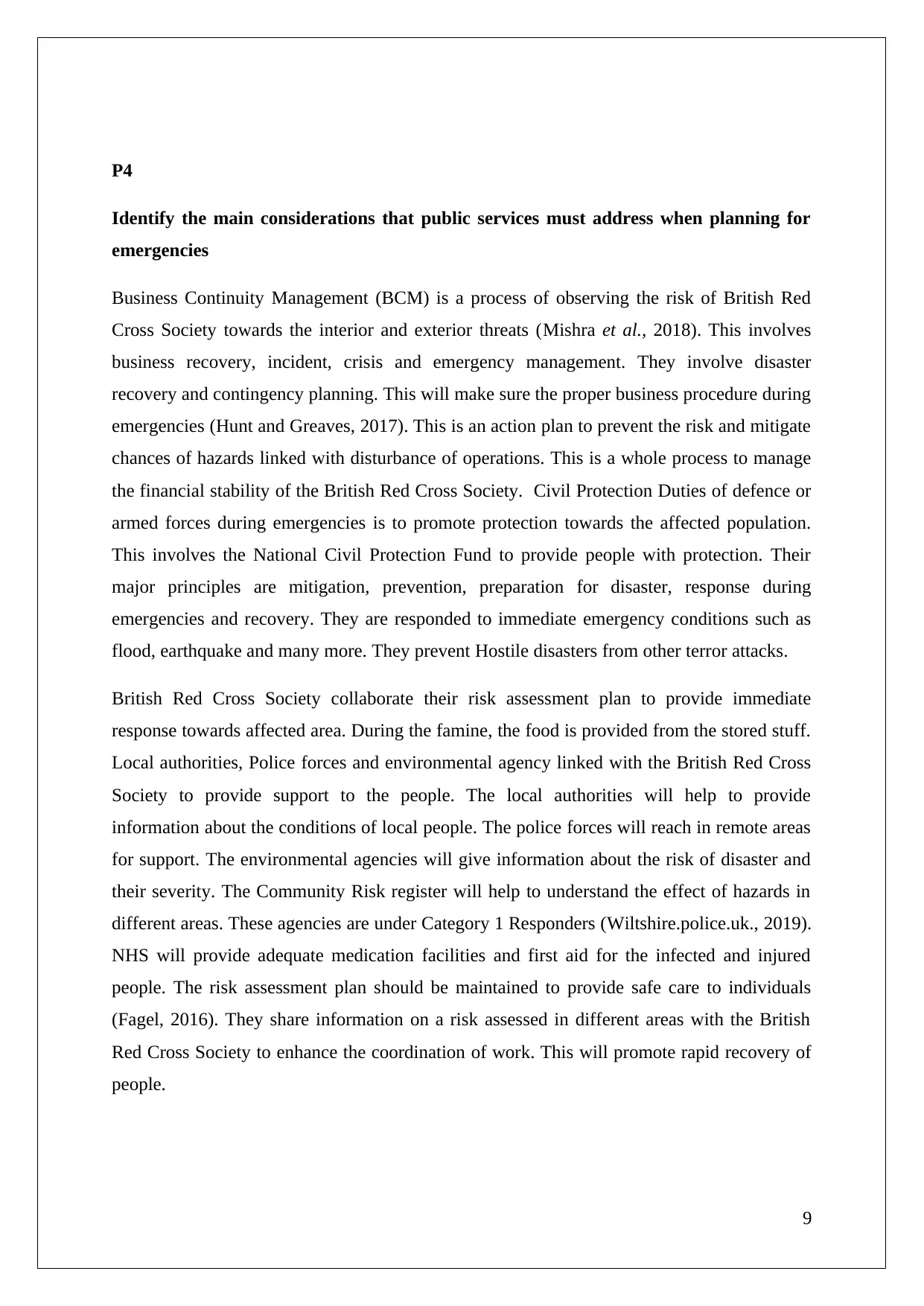
P4
Identify the main considerations that public services must address when planning for
emergencies
Business Continuity Management (BCM) is a process of observing the risk of British Red
Cross Society towards the interior and exterior threats (Mishra et al., 2018). This involves
business recovery, incident, crisis and emergency management. They involve disaster
recovery and contingency planning. This will make sure the proper business procedure during
emergencies (Hunt and Greaves, 2017). This is an action plan to prevent the risk and mitigate
chances of hazards linked with disturbance of operations. This is a whole process to manage
the financial stability of the British Red Cross Society. Civil Protection Duties of defence or
armed forces during emergencies is to promote protection towards the affected population.
This involves the National Civil Protection Fund to provide people with protection. Their
major principles are mitigation, prevention, preparation for disaster, response during
emergencies and recovery. They are responded to immediate emergency conditions such as
flood, earthquake and many more. They prevent Hostile disasters from other terror attacks.
British Red Cross Society collaborate their risk assessment plan to provide immediate
response towards affected area. During the famine, the food is provided from the stored stuff.
Local authorities, Police forces and environmental agency linked with the British Red Cross
Society to provide support to the people. The local authorities will help to provide
information about the conditions of local people. The police forces will reach in remote areas
for support. The environmental agencies will give information about the risk of disaster and
their severity. The Community Risk register will help to understand the effect of hazards in
different areas. These agencies are under Category 1 Responders (Wiltshire.police.uk., 2019).
NHS will provide adequate medication facilities and first aid for the infected and injured
people. The risk assessment plan should be maintained to provide safe care to individuals
(Fagel, 2016). They share information on a risk assessed in different areas with the British
Red Cross Society to enhance the coordination of work. This will promote rapid recovery of
people.
9
Identify the main considerations that public services must address when planning for
emergencies
Business Continuity Management (BCM) is a process of observing the risk of British Red
Cross Society towards the interior and exterior threats (Mishra et al., 2018). This involves
business recovery, incident, crisis and emergency management. They involve disaster
recovery and contingency planning. This will make sure the proper business procedure during
emergencies (Hunt and Greaves, 2017). This is an action plan to prevent the risk and mitigate
chances of hazards linked with disturbance of operations. This is a whole process to manage
the financial stability of the British Red Cross Society. Civil Protection Duties of defence or
armed forces during emergencies is to promote protection towards the affected population.
This involves the National Civil Protection Fund to provide people with protection. Their
major principles are mitigation, prevention, preparation for disaster, response during
emergencies and recovery. They are responded to immediate emergency conditions such as
flood, earthquake and many more. They prevent Hostile disasters from other terror attacks.
British Red Cross Society collaborate their risk assessment plan to provide immediate
response towards affected area. During the famine, the food is provided from the stored stuff.
Local authorities, Police forces and environmental agency linked with the British Red Cross
Society to provide support to the people. The local authorities will help to provide
information about the conditions of local people. The police forces will reach in remote areas
for support. The environmental agencies will give information about the risk of disaster and
their severity. The Community Risk register will help to understand the effect of hazards in
different areas. These agencies are under Category 1 Responders (Wiltshire.police.uk., 2019).
NHS will provide adequate medication facilities and first aid for the infected and injured
people. The risk assessment plan should be maintained to provide safe care to individuals
(Fagel, 2016). They share information on a risk assessed in different areas with the British
Red Cross Society to enhance the coordination of work. This will promote rapid recovery of
people.
9
⊘ This is a preview!⊘
Do you want full access?
Subscribe today to unlock all pages.

Trusted by 1+ million students worldwide
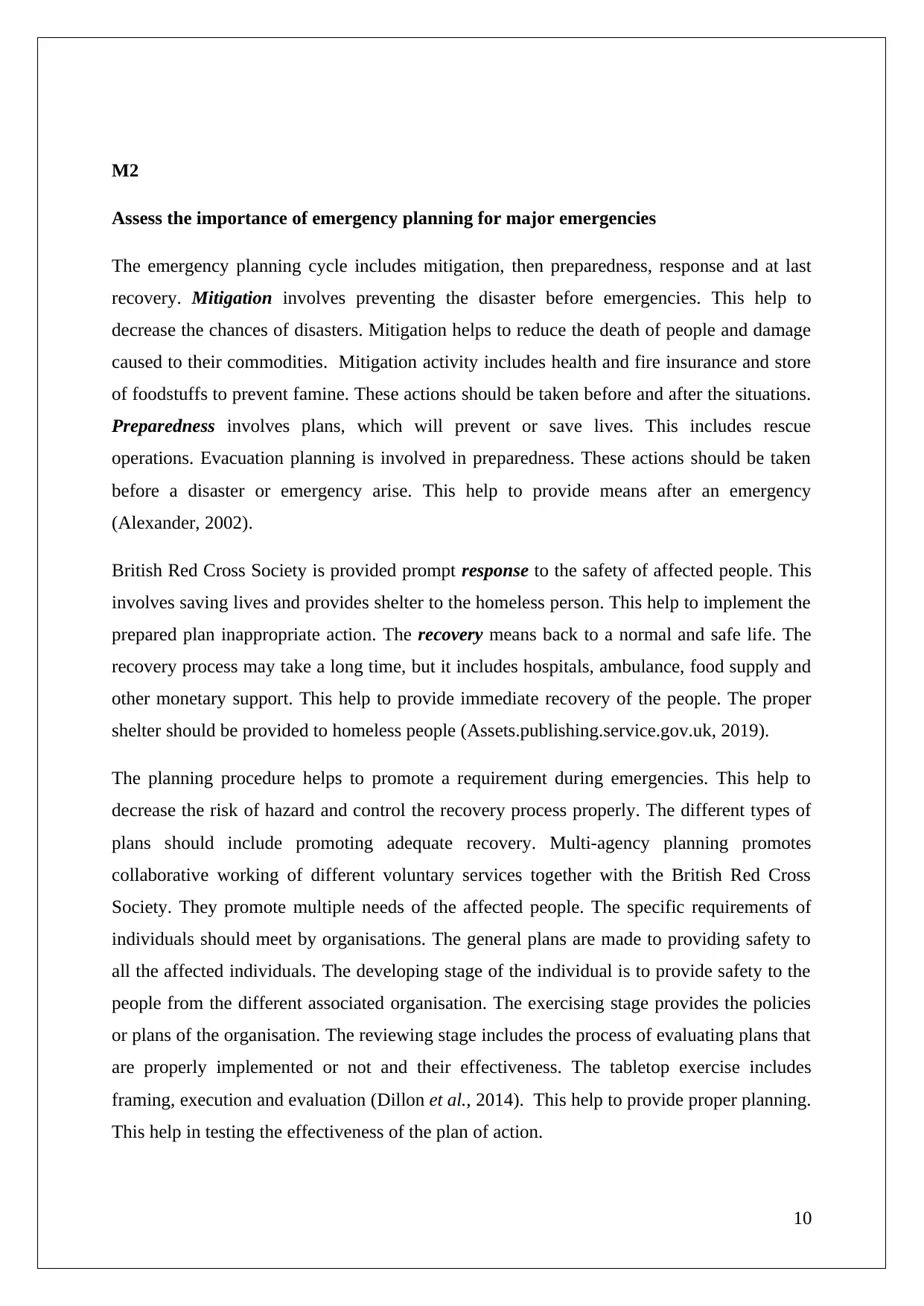
M2
Assess the importance of emergency planning for major emergencies
The emergency planning cycle includes mitigation, then preparedness, response and at last
recovery. Mitigation involves preventing the disaster before emergencies. This help to
decrease the chances of disasters. Mitigation helps to reduce the death of people and damage
caused to their commodities. Mitigation activity includes health and fire insurance and store
of foodstuffs to prevent famine. These actions should be taken before and after the situations.
Preparedness involves plans, which will prevent or save lives. This includes rescue
operations. Evacuation planning is involved in preparedness. These actions should be taken
before a disaster or emergency arise. This help to provide means after an emergency
(Alexander, 2002).
British Red Cross Society is provided prompt response to the safety of affected people. This
involves saving lives and provides shelter to the homeless person. This help to implement the
prepared plan inappropriate action. The recovery means back to a normal and safe life. The
recovery process may take a long time, but it includes hospitals, ambulance, food supply and
other monetary support. This help to provide immediate recovery of the people. The proper
shelter should be provided to homeless people (Assets.publishing.service.gov.uk, 2019).
The planning procedure helps to promote a requirement during emergencies. This help to
decrease the risk of hazard and control the recovery process properly. The different types of
plans should include promoting adequate recovery. Multi-agency planning promotes
collaborative working of different voluntary services together with the British Red Cross
Society. They promote multiple needs of the affected people. The specific requirements of
individuals should meet by organisations. The general plans are made to providing safety to
all the affected individuals. The developing stage of the individual is to provide safety to the
people from the different associated organisation. The exercising stage provides the policies
or plans of the organisation. The reviewing stage includes the process of evaluating plans that
are properly implemented or not and their effectiveness. The tabletop exercise includes
framing, execution and evaluation (Dillon et al., 2014). This help to provide proper planning.
This help in testing the effectiveness of the plan of action.
10
Assess the importance of emergency planning for major emergencies
The emergency planning cycle includes mitigation, then preparedness, response and at last
recovery. Mitigation involves preventing the disaster before emergencies. This help to
decrease the chances of disasters. Mitigation helps to reduce the death of people and damage
caused to their commodities. Mitigation activity includes health and fire insurance and store
of foodstuffs to prevent famine. These actions should be taken before and after the situations.
Preparedness involves plans, which will prevent or save lives. This includes rescue
operations. Evacuation planning is involved in preparedness. These actions should be taken
before a disaster or emergency arise. This help to provide means after an emergency
(Alexander, 2002).
British Red Cross Society is provided prompt response to the safety of affected people. This
involves saving lives and provides shelter to the homeless person. This help to implement the
prepared plan inappropriate action. The recovery means back to a normal and safe life. The
recovery process may take a long time, but it includes hospitals, ambulance, food supply and
other monetary support. This help to provide immediate recovery of the people. The proper
shelter should be provided to homeless people (Assets.publishing.service.gov.uk, 2019).
The planning procedure helps to promote a requirement during emergencies. This help to
decrease the risk of hazard and control the recovery process properly. The different types of
plans should include promoting adequate recovery. Multi-agency planning promotes
collaborative working of different voluntary services together with the British Red Cross
Society. They promote multiple needs of the affected people. The specific requirements of
individuals should meet by organisations. The general plans are made to providing safety to
all the affected individuals. The developing stage of the individual is to provide safety to the
people from the different associated organisation. The exercising stage provides the policies
or plans of the organisation. The reviewing stage includes the process of evaluating plans that
are properly implemented or not and their effectiveness. The tabletop exercise includes
framing, execution and evaluation (Dillon et al., 2014). This help to provide proper planning.
This help in testing the effectiveness of the plan of action.
10
Paraphrase This Document
Need a fresh take? Get an instant paraphrase of this document with our AI Paraphraser
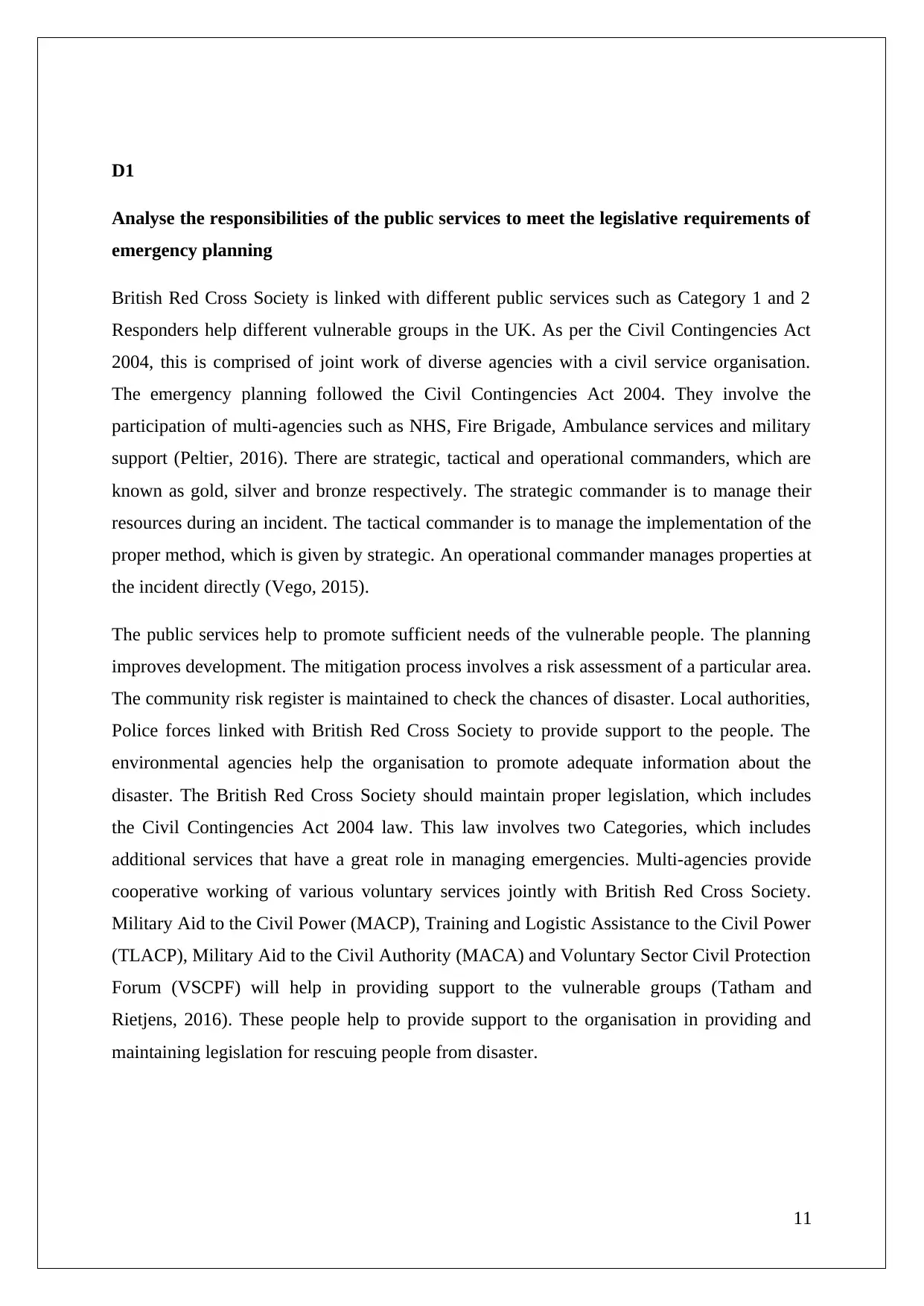
D1
Analyse the responsibilities of the public services to meet the legislative requirements of
emergency planning
British Red Cross Society is linked with different public services such as Category 1 and 2
Responders help different vulnerable groups in the UK. As per the Civil Contingencies Act
2004, this is comprised of joint work of diverse agencies with a civil service organisation.
The emergency planning followed the Civil Contingencies Act 2004. They involve the
participation of multi-agencies such as NHS, Fire Brigade, Ambulance services and military
support (Peltier, 2016). There are strategic, tactical and operational commanders, which are
known as gold, silver and bronze respectively. The strategic commander is to manage their
resources during an incident. The tactical commander is to manage the implementation of the
proper method, which is given by strategic. An operational commander manages properties at
the incident directly (Vego, 2015).
The public services help to promote sufficient needs of the vulnerable people. The planning
improves development. The mitigation process involves a risk assessment of a particular area.
The community risk register is maintained to check the chances of disaster. Local authorities,
Police forces linked with British Red Cross Society to provide support to the people. The
environmental agencies help the organisation to promote adequate information about the
disaster. The British Red Cross Society should maintain proper legislation, which includes
the Civil Contingencies Act 2004 law. This law involves two Categories, which includes
additional services that have a great role in managing emergencies. Multi-agencies provide
cooperative working of various voluntary services jointly with British Red Cross Society.
Military Aid to the Civil Power (MACP), Training and Logistic Assistance to the Civil Power
(TLACP), Military Aid to the Civil Authority (MACA) and Voluntary Sector Civil Protection
Forum (VSCPF) will help in providing support to the vulnerable groups (Tatham and
Rietjens, 2016). These people help to provide support to the organisation in providing and
maintaining legislation for rescuing people from disaster.
11
Analyse the responsibilities of the public services to meet the legislative requirements of
emergency planning
British Red Cross Society is linked with different public services such as Category 1 and 2
Responders help different vulnerable groups in the UK. As per the Civil Contingencies Act
2004, this is comprised of joint work of diverse agencies with a civil service organisation.
The emergency planning followed the Civil Contingencies Act 2004. They involve the
participation of multi-agencies such as NHS, Fire Brigade, Ambulance services and military
support (Peltier, 2016). There are strategic, tactical and operational commanders, which are
known as gold, silver and bronze respectively. The strategic commander is to manage their
resources during an incident. The tactical commander is to manage the implementation of the
proper method, which is given by strategic. An operational commander manages properties at
the incident directly (Vego, 2015).
The public services help to promote sufficient needs of the vulnerable people. The planning
improves development. The mitigation process involves a risk assessment of a particular area.
The community risk register is maintained to check the chances of disaster. Local authorities,
Police forces linked with British Red Cross Society to provide support to the people. The
environmental agencies help the organisation to promote adequate information about the
disaster. The British Red Cross Society should maintain proper legislation, which includes
the Civil Contingencies Act 2004 law. This law involves two Categories, which includes
additional services that have a great role in managing emergencies. Multi-agencies provide
cooperative working of various voluntary services jointly with British Red Cross Society.
Military Aid to the Civil Power (MACP), Training and Logistic Assistance to the Civil Power
(TLACP), Military Aid to the Civil Authority (MACA) and Voluntary Sector Civil Protection
Forum (VSCPF) will help in providing support to the vulnerable groups (Tatham and
Rietjens, 2016). These people help to provide support to the organisation in providing and
maintaining legislation for rescuing people from disaster.
11
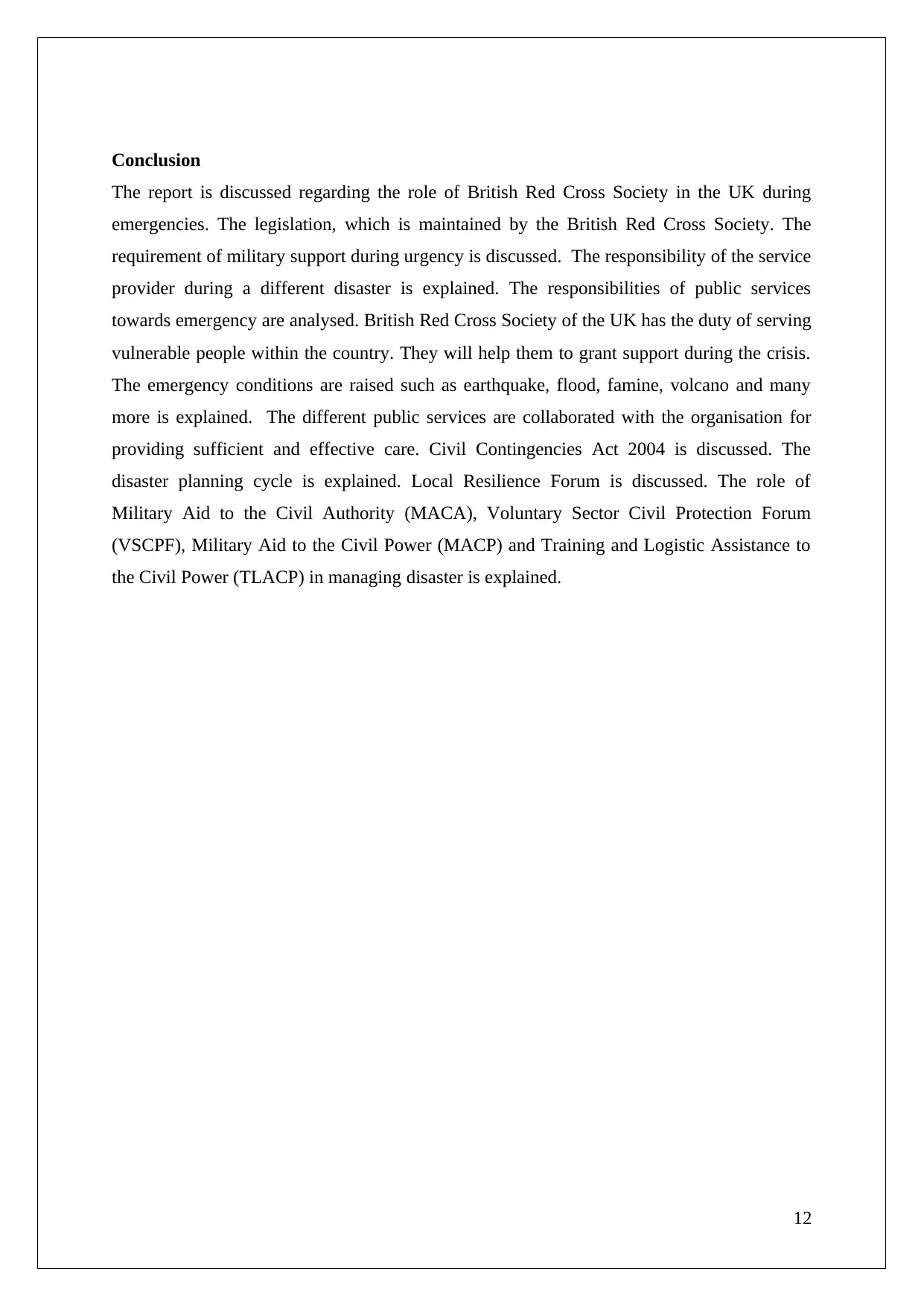
Conclusion
The report is discussed regarding the role of British Red Cross Society in the UK during
emergencies. The legislation, which is maintained by the British Red Cross Society. The
requirement of military support during urgency is discussed. The responsibility of the service
provider during a different disaster is explained. The responsibilities of public services
towards emergency are analysed. British Red Cross Society of the UK has the duty of serving
vulnerable people within the country. They will help them to grant support during the crisis.
The emergency conditions are raised such as earthquake, flood, famine, volcano and many
more is explained. The different public services are collaborated with the organisation for
providing sufficient and effective care. Civil Contingencies Act 2004 is discussed. The
disaster planning cycle is explained. Local Resilience Forum is discussed. The role of
Military Aid to the Civil Authority (MACA), Voluntary Sector Civil Protection Forum
(VSCPF), Military Aid to the Civil Power (MACP) and Training and Logistic Assistance to
the Civil Power (TLACP) in managing disaster is explained.
12
The report is discussed regarding the role of British Red Cross Society in the UK during
emergencies. The legislation, which is maintained by the British Red Cross Society. The
requirement of military support during urgency is discussed. The responsibility of the service
provider during a different disaster is explained. The responsibilities of public services
towards emergency are analysed. British Red Cross Society of the UK has the duty of serving
vulnerable people within the country. They will help them to grant support during the crisis.
The emergency conditions are raised such as earthquake, flood, famine, volcano and many
more is explained. The different public services are collaborated with the organisation for
providing sufficient and effective care. Civil Contingencies Act 2004 is discussed. The
disaster planning cycle is explained. Local Resilience Forum is discussed. The role of
Military Aid to the Civil Authority (MACA), Voluntary Sector Civil Protection Forum
(VSCPF), Military Aid to the Civil Power (MACP) and Training and Logistic Assistance to
the Civil Power (TLACP) in managing disaster is explained.
12
⊘ This is a preview!⊘
Do you want full access?
Subscribe today to unlock all pages.

Trusted by 1+ million students worldwide
1 out of 18
Related Documents
Your All-in-One AI-Powered Toolkit for Academic Success.
+13062052269
info@desklib.com
Available 24*7 on WhatsApp / Email
![[object Object]](/_next/static/media/star-bottom.7253800d.svg)
Unlock your academic potential
Copyright © 2020–2025 A2Z Services. All Rights Reserved. Developed and managed by ZUCOL.


